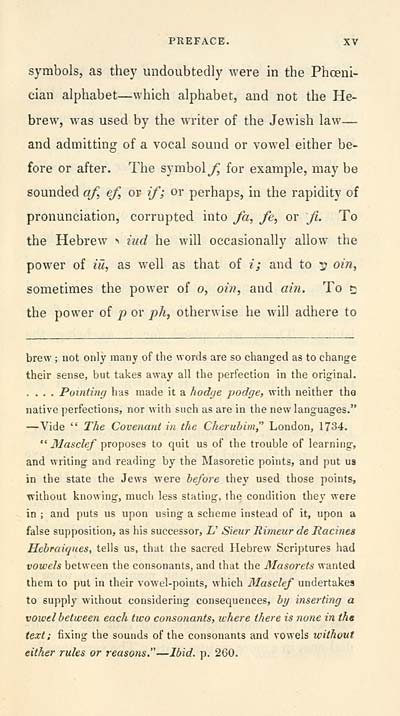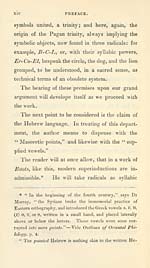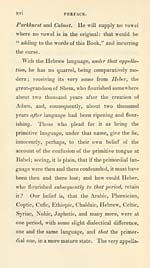Download files
Complete book:
Individual page:
Thumbnail gallery: Grid view | List view

symbols, as they undoubtedly were in the Phoeni-
cian alphabet — which alphabet, and not the He-
brew, was used by the Avriter of the Jewish law —
and admitting of a vocal sound or vowel either be-
fore or after. The symbol yj for example, may be
sounded af,ef,ov if; or perhaps, in the rapidity of
pronunciation, corrupted into fa, fe, or fi. To
the Hebrew ^ hid he will occasionally allow the
power of ill, as well as that of i; and to 2? oin,
sometimes the power of 0, oin, and ain. To 5
the power of p or ph, otherwise he will adhere to
brew ; not only many of the words are so changed as to change
their sense, but takes away all the perfection in the original.
.... Pointing has made it a hodge podge, with neither the
native perfections, nor with such as are in the new languages."
— Vide " The Coveiiant in the Cherubim," London, 1734.
" Masclef proposes to quit us of the trouble of learning,
and writing and reading by the Masoretic points, and put us
in the state the Jews were before they used those points,
without knowing, much less stating, the condition they were
in ; and puts us upon using a scheme instead of it, upon a
false supposition, as his successor, U Sieur Rimeur de Racines
Hebraiques, tells us, that the sacred Hebrew Scriptures had
vowels between the consonants, and that the 3Iasorets wanted
them to put in their vowel-points, which Masclef undertakes
to supply without considering consequences, by inserting a
voivel between each two consonants, where there is none in ths
text; fixing the sounds of the consonants and vowels without
either rules or reasons" — Ibid. p. 260.
cian alphabet — which alphabet, and not the He-
brew, was used by the Avriter of the Jewish law —
and admitting of a vocal sound or vowel either be-
fore or after. The symbol yj for example, may be
sounded af,ef,ov if; or perhaps, in the rapidity of
pronunciation, corrupted into fa, fe, or fi. To
the Hebrew ^ hid he will occasionally allow the
power of ill, as well as that of i; and to 2? oin,
sometimes the power of 0, oin, and ain. To 5
the power of p or ph, otherwise he will adhere to
brew ; not only many of the words are so changed as to change
their sense, but takes away all the perfection in the original.
.... Pointing has made it a hodge podge, with neither the
native perfections, nor with such as are in the new languages."
— Vide " The Coveiiant in the Cherubim," London, 1734.
" Masclef proposes to quit us of the trouble of learning,
and writing and reading by the Masoretic points, and put us
in the state the Jews were before they used those points,
without knowing, much less stating, the condition they were
in ; and puts us upon using a scheme instead of it, upon a
false supposition, as his successor, U Sieur Rimeur de Racines
Hebraiques, tells us, that the sacred Hebrew Scriptures had
vowels between the consonants, and that the 3Iasorets wanted
them to put in their vowel-points, which Masclef undertakes
to supply without considering consequences, by inserting a
voivel between each two consonants, where there is none in ths
text; fixing the sounds of the consonants and vowels without
either rules or reasons" — Ibid. p. 260.
Set display mode to: Large image | Transcription
Images and transcriptions on this page, including medium image downloads, may be used under the Creative Commons Attribution 4.0 International Licence unless otherwise stated. ![]()
| Early Gaelic Book Collections > Blair Collection > History of the Celtic language > (21) |
|---|
| Permanent URL | https://digital.nls.uk/76178840 |
|---|
| Description | A selection of books from a collection of more than 500 titles, mostly on religious and literary topics. Also includes some material dealing with other Celtic languages and societies. Collection created towards the end of the 19th century by Lady Evelyn Stewart Murray. |
|---|
| Description | Selected items from five 'Special and Named Printed Collections'. Includes books in Gaelic and other Celtic languages, works about the Gaels, their languages, literature, culture and history. |
|---|

